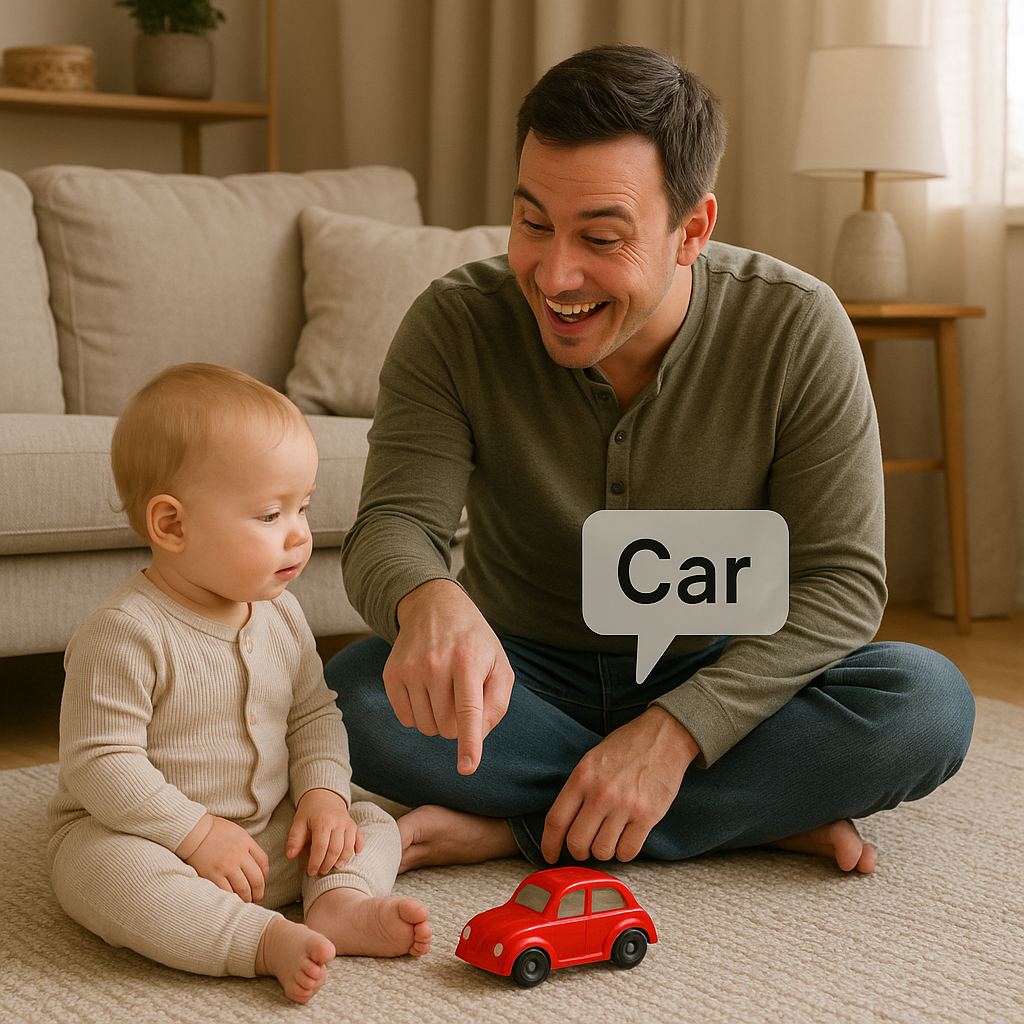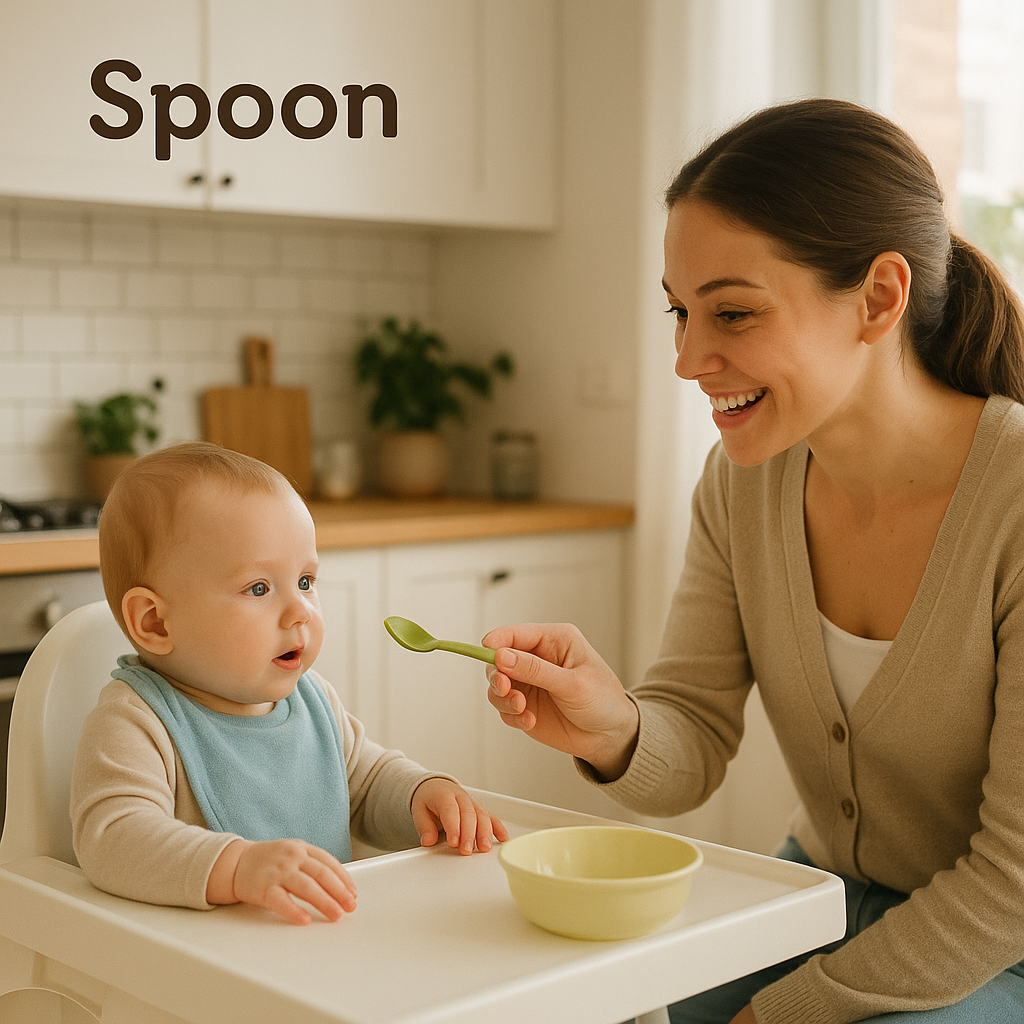Did you know that naming objects for your baby can help them learn words quickly? Research suggests babies can remember a word after hearing it just a few times, setting the stage for a strong vocabulary. Learn about rapid word learning in toddlers. By adding simple labels like “ball” or “spoon” to daily routines, you’re giving your baby’s brain the tools to grow their language skills.
- What exactly is object labeling, and why does it matter?
- How does labeling objects build brain pathways for vocabulary growth?
- When is the best time to label, and which routines work fastest?
- Which strategies super-charge labeling—and which can slow babies down?
- What red flags suggest labeling isn’t enough, and what should you do?
- Your Top Questions, Answered
- Can a few mindful labels today shape a lifetime of language?
What exactly is object labeling, and why does it matter?
Object labeling is when you name what your baby is looking at, touching, or playing with, like saying “dog” when they see a pet. It’s not just pointing to show them; it’s helping them say the word themselves. Studies show that babies as young as 13 months can connect a word to an object after hearing it a few times, a process called fast mapping.
Each label acts like a sticky note in your baby’s brain, helping them later ask for things or share ideas. Want to know how this fits with everyday talking? Check out How Talking to Your Baby Boosts Language and Brain Skills.

How does labeling objects build brain pathways for vocabulary growth?
When you and your baby look at the same object and you name it, their brain gets busy. Special cells called mirror neurons and language networks work together to link the word to the object. By 20 months, babies can tell real words from nonsense sounds, showing their brain is wired for language. Explore brain mechanisms in language learning.
Labeling also helps close the “30 Million Word Gap,” where some kids hear fewer words due to family circumstances. More labels mean more words, which can lead to a bigger vocabulary by age 3. Understand the word gap. This sets your baby up for a language burst between 18 and 24 months
When is the best time to label, and which routines work fastest?
You can start labeling early, following your baby’s interests:
- 4–6 months: Babies notice sounds; name toys or objects they love.
- 9–12 months: They start connecting words to things; label what they grab or stare at.
- 18–24 months: Their vocabulary grows fast; repeat favorite words and add new ones.
The best times to label are during daily routines like meals (“banana”), diaper changes (“wipe”), walks (“tree”), or story time, where pictures and words work together.
Example at lunch:
“Here’s your spoon. Spoon. It’s shiny. Let’s scoop yogurt with the spoon.” Reading to Your Baby: Boosting Language from Birth.

Which strategies super-charge labeling—and which can slow babies down?
Here are five ways to make labeling fun and effective:
- Comment More Than Ask: Say “This is a ball” three times before asking “What’s this?” to keep it stress-free.
- Repeat in New Places: Say “ball” at home, the park, and bath time to help them remember.
- Touch and Tell: Let your baby hold the object while you name it for a stronger connection.
- Bilingual Bonus: If you speak two languages, name objects in both, but keep them separate. Learn more at Raising a Bilingual Baby.
- Add Written Labels: After 15 months, stick labels on objects to spark early reading.
If your baby looks bored or turns away, pause and try again when they’re interested. Keep it playful with smiles and a sing-song voice.
What red flags suggest labeling isn’t enough, and what should you do?
If your baby isn’t saying familiar words by 14 months or asking for things with words by 16 months, it might be a sign to check in with a doctor. First, make sure they can hear well, then talk to a speech expert. Early help can make a big difference. Check speech milestones.
Quick Check:
- Do they respond to their name?
- Do they use at least five gestures (like waving) by 12 months?
- Do they enjoy looking at books with you?
Worried about screen time? See Screen Time and Speech Delay: How to Protect Your Baby.
Your Top Questions, Answered
-
What’s the difference between labeling and “baby talk”?
Labeling uses real, clear words (“bottle”) often in a sing-song parentese tone. Classic baby talk like “goo-goo” doesn’t build vocabulary. -
**Does labeling work for verbs and adjectives? Yes. Start with concrete nouns, then add actions (“jump”) and qualities (“squishy”) as comprehension grows.
-
Should I put physical labels on objects? Helpful after about 15 months. Pair spoken and written words to spark early reading skills.
-
How many new words should I aim for each week? Five to seven fresh labels, repeated across routines, give ample exposure without overload.
For milestone benchmarks, visit Baby Language Milestones: First Year Guide for Parents.
Can a few mindful labels today shape a lifetime of language?
Absolutely. Naming objects during shared moments wires your baby’s brain for the upcoming word burst, fuels confidence, and lays the groundwork for reading and rich conversation. Download our free “Label-Around-the-House Starter Kit,” and explore next steps in Helping Your Baby Say First Words: Tips and Tricks. Your warm words today unlock a future filled with your child’s own.